Many military aircraft go through protracted development after they enter service, being refined and improved through the experience of combat. Sometimes, it takes several iterations before an aircraft is refined to the point that it is truly effective.
But very occasionally a new aircraft appears that is pretty much perfect right out of the box. This is the story of one such fighter: the Grumman F6F Hellcat.
During its long service career, it went through just one minor upgrade, but it proved to be the most successful fighter in the Pacific Theatre as well as an outstanding strike aircraft.
In terms of technology, there was nothing about the F6F that was especially innovative or radical, so, just what was it about this tough, stubby naval aircraft that made it so good?
 A pair of Hellcats May 1943.
A pair of Hellcats May 1943.
Origin
The Grumman Aircraft Engineering Corporation specialised in producing aircraft for naval operations. The prototype of their first monoplane fighter, the F4F Wildcat, was completed in 1937, but it lost out to the Brewster Buffalo in USN trails.
The F4F simply didn’t handle as well as the Buffalo and it had a nasty, narrow, complex, hand-cranked undercarriage, a legacy from its original design as a biplane.
Grumman improved the F4F by fitting a more powerful engine and the Wildcat went on to serve throughout World War Two, becoming the only USN fighter in service when the war began in December 1941 and still flying operationally when Japan finally surrendered in August 1945.
The F4F was an impressive aircraft, but it did have a couple of notable drawbacks.
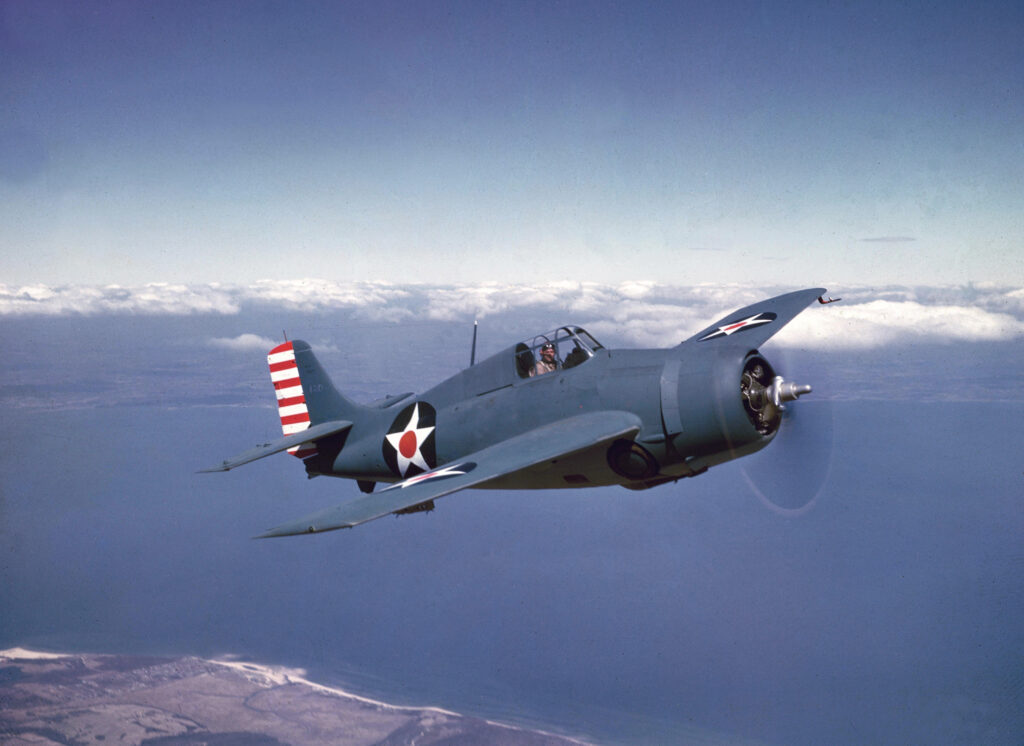 The F4F was a formidable early war aircraft but did have drawbacks.
The F4F was a formidable early war aircraft but did have drawbacks.
The first was a lack of power. Its Pratt & Whitney radial engine gave it a reasonable top speed at altitude, but take-off power was limited. Experiments with F4Fs carrying rockets or bombs were abandoned, mainly because when carrying external armaments, a carrier take-off became fraught with risk.
Just about everyone who flew the F4F hated its hand-cranked undercarriage. It took over 30 turns of the small, stiff crank handle to get the gear fully up or down, and if a pilot’s hand slipped off the lever, hand and wrist injuries were common.
What was needed was a fighter that was just as rugged and reliable as the F4F but with more power and hydraulic gear.
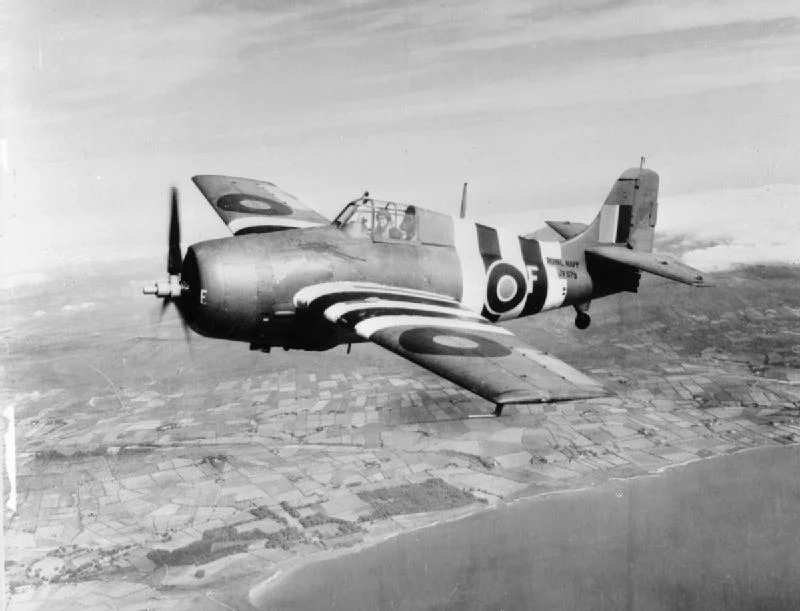 The Royal Navy also used the F4F, known as the Martlet.
The Royal Navy also used the F4F, known as the Martlet.
Development
There almost wasn’t an F6F at all. Almost as soon as the F4F entered service, Grumman engineers were working on its successor, initially called the Super Wildcat, with more power and hydraulic gear.
But the US Navy wasn’t particularly interested. In February 1938 the U.S. Navy Bureau of Aeronautics issued a Request for Proposals for a single-engine fighter with “maximum obtainable speed.”
Chance Vought responded with the V-166B, given the USN designation XF4U-1 and soon to become famous as the Corsair. In October 1940, the XF4U-1 became the first US single-engine fighter to exceed 400mph in level flight. Within the Navy, there was an assumption that the F4U would replace the F4F in USN service.
However, there were unexpected delays in the development of the Corsair. Early versions had difficult spin recovery characteristics, a tendency to stall during low-speed carrier approaches and the long nose limited visibility at high angles of attack.
 The prototype XF6F-1 Hellcat.
The prototype XF6F-1 Hellcat.
Addressing these problems caused delays which meant that the Corsair wouldn’t enter USN front-line service until late 1944 and something better than the F4F was needed quickly in the meantime.
The Grumman proposal for a Super Wildcat seemed like a logical interim solution. It wasn’t entirely new, simply a development of an existing fighter and while it might not have the performance of the F4U, it could probably be developed quickly. In June 1941, Grumman was awarded a contract to produce a prototype of what was designated the XF6F-1.
This was essentially an enlarged Wildcat, changed to a low-wing configuration, powered by a 1,700 hp Wright R-2600 Twin Cyclone radial engine (the same engine that Grumman was using on the new torpedo bomber they were working on, the TBF) and provided with a wider track, hydraulicly powered undercarriage where each leg rotated through 90˚ before retracting to the rear.
 An F6F having the wings folded back by the crew.
An F6F having the wings folded back by the crew.
Armament was to be identical to that fitted to the F4F, comprising six 0.50 calibre machine guns mounted in the wings. The F6F also inherited a Grumman proprietary innovation introduced on the F4F-4, the Sto-Wing, a manual folding system for the wings that reduced the space needed to store aircraft on deck or in the hangar on carriers.
Flight testing showed that the new aircraft was stable and easy to fly, but disappointingly, it wasn’t a great deal faster than the F4F.
Then, someone had the bright idea of fitting the new aircraft with the 2,000 hp Pratt & Whitney R-2800 radial engine, the same engine used in the F4U and the P-47 Thunderbolt. The XF6F-2 used a turbocharged version of this engine, and it wasn’t bad at all.
The XF6F-3 was fitted with the same engine equipped with a two-stage supercharger. It first flew in July 1942 and its performance was outstanding.
The USN immediately placed orders for the new fighter and the first production F6F-3 rolled out of the Grumman works less than four months later.
 The F6F-3 was the production model.
The F6F-3 was the production model.
The F6F
There was nothing radical about the design of the F6F-3. It was a low-wing, all-metal monoplane powered by a supercharged Pratt & Whitney R-2800 radial engine driving a three-blade propellor.
Though it looked similar to the F4F, this was actually a completely different and much larger aircraft, only a few inches smaller overall that the mighty P-47 Thunderbolt.
But perhaps no other aircraft better illustrates Grumman’s design philosophy of “make it strong, make it work and make it simple.”
The airframe and undercarriage were simple, rugged and resilient. The pilot was protected by over 200lb of armour and a bullet-proof windscreen. The fuel tanks were self-sealing and the oil tank and oil cooler were also protected by armour.
 F6F-5 with HVAR rockets.
F6F-5 with HVAR rockets.
The F6F proved capable of absorbing a great deal of combat damage and still bringing its pilot safely back to base. Best of all, the F6F was a delight to fly.
Its cockpit was set high in the fuselage and the nose was sloped down to give the pilot a wonderful view of a carrier deck during the approach. Although it was considerably faster than the F4F, the F6F had a slower landing speed.
Its handling was predictable, vice-free and stable: it was, according to Grumman, designed to be flown safely by inexperienced pilots, “200-hour farmboys.”
During its service career, there was only one minor upgrade to this aircraft, the F6F-5 which differed from the original only in being powered by a Pratt & Whitney R-2800-10W engine that provided an additional 200 hp.
There were also a small number of night-fighter versions (the F6F-3N/5N) fitted with radar pods and photo-reconnaissance versions with camera packs.
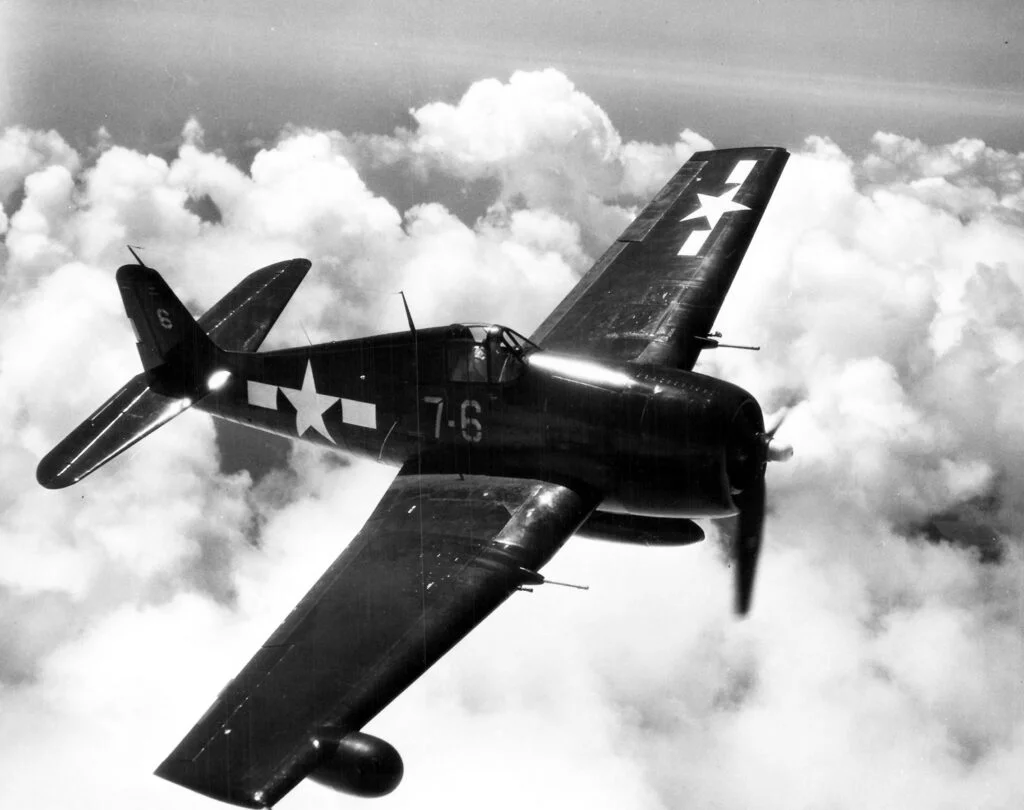 F6F-5N with the radar pod and 20mm cannons.
F6F-5N with the radar pod and 20mm cannons.
But the vast majority of F6Fs were manufactured as fighters, though most were also upgraded to act in the strike-fighter role, carrying up to six HVAR rockets or up to 2,000 lb of bombs on underwing racks.
In Service
It took a surprisingly long time for this aircraft to be given a name, perhaps because no one expected it to last very long before being replaced by the Corsair. Initially, Grumman considered naming it the “Tomcat”, but, after more than 1,000 F6F-3s had rolled off the production line, it was finally given the name by which it is now remembered: Hellcat.
The US Navy seems to have been taken by surprise by just how good the F6F was. They discovered that, while it wasn’t nearly as fast as the F4U (385 mph for the F6F compared to over 450 mph for the F4U), it was much easier to fly and operate from carriers.
From an aircraft that was ordered as a slightly reluctant interim measure, the F6F was transformed into the USN’s most important fighter.
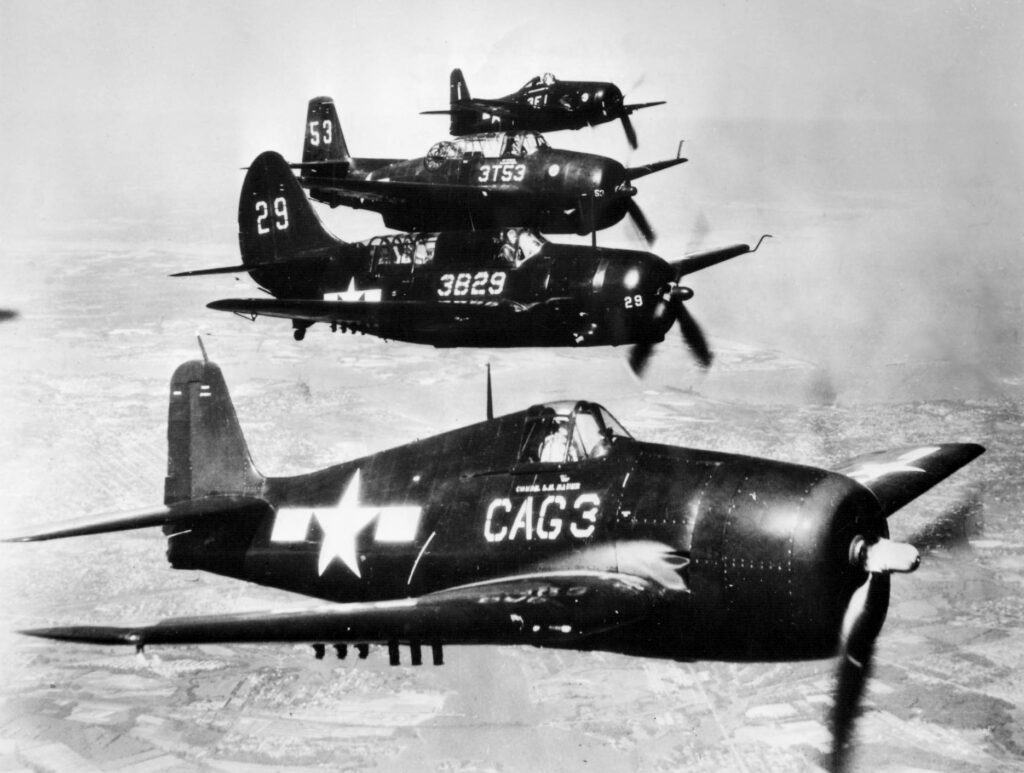 Hellcat, Helldiver, Avenger, and Bearcat in flight together.
Hellcat, Helldiver, Avenger, and Bearcat in flight together.
In the space of a little over 30 months, Grumman produced over 12,000 F6Fs. By the time of the Battle of Leyte Gulf in October 1944, the US navy was able to field over 500 fighters operating from several carriers. Everyone was an F6F Hellcat. More USN aces flew the F6F than any other aircraft.
USN F6Fs are credited with destroying over 5,000 enemy aircraft and accounted for almost 75% of all enemy aircraft destroyed by the USN in World War Two.
Overall, the F6F is believed to have achieved a kill ratio of 19:1 in air combat, one of the best kill ratios for any fighter in World War Two. Not a bad record for a temporary solution!
Over 1,000 F6Fs were also used by the British Royal Navy Fleet Air Arm, where they were initially known as “Gannets” before formally adopting the Hellcat name.
These aircraft flew and fought over the Mediterranean, Atlantic and North Sea and (in conjunction with USN F6Fs) provided air support during Operation Dragoon, the Allied landing in southern France in August 1944.
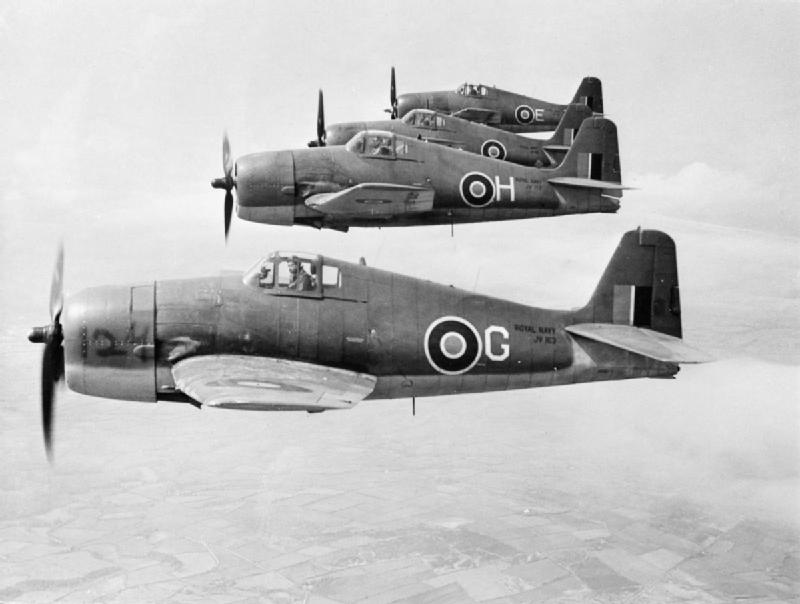 The RAF also used the Hellcat after its success with the F4F.
The RAF also used the Hellcat after its success with the F4F.
The USN began to phase out the F6F almost as soon as World War Two ended, while retaining the F4U Corsair. By the time that the Korean War began in June 1950, only a handful of F6F night fighters, drones and training aircraft remained in service.
The last USN F6Fs were scrapped in 1954 and the F6F was replaced by the Grumman F8F Bearcat. The French Navy purchased over 100 surpluses of USN F6F-5s and a few night fighters between 1950 and 1953 and these aircraft would see service operating from French carriers during the war in French Indo-China (present-day Vietnam). This would be the last time that the F6F would be used in fighter/strike fighter combat operations.
Conclusions
Few military aircraft are truly effective from the moment that they enter service. The F6F was the exception to this rule. The production F6F-3 differed from the prototype XF6F-3 only in detail and during its service career there was only one minor upgrade to producing the slightly faster F6F-5. That is a testament to just how good this aircraft was from the very beginning.
 The Bearcat missed the end of the war. Airwolfhound CC BY-SA 2.0.
The Bearcat missed the end of the war. Airwolfhound CC BY-SA 2.0.
Grumman’s policy of producing tough, simple aircraft that could be flown effectively even by relatively inexperienced pilots has never been better illustrated.
While landing and take-off accidents with the fast but challenging F4U Corsair gained it a reputation in the US Navy as the “ensign eliminator,” the docile handling and low landing speed of the F6F caused no such problems.
This, combined with a rugged airframe with armour protecting the pilot and vital areas made it capable of absorbing staggering amounts of combat damage while staying in the air.
Many histories overlook the F6F and aviation enthusiasts seem more excited by the F4U. That’s unfair. This truly was an outstanding aircraft straight out of the box and if there is a single fighter that contributed most to winning the Pacific air war, it was the forgotten F6F Hellcat.





